AMD Radeon HD 7870 GHz Edition & Radeon HD 7850 Review: Rounding Out Southern Islands
by Ryan Smith on March 5, 2012 12:01 AM ESTOverclocking: Power, Temp, & Noise
As with the rest of Southern Islands, AMD is making sure to promote the overclockability of their cards. And why not? So far we’ve seen every 7700 and 7900 card overclock by at least 12% on stock voltage, indicating there’s a surprising amount of headroom in these cards. The fact that performance has been scaling so well with overclocking only makes overclocking even more enticing. Who doesn’t want free performance?
So how does Pircairn and the 7800 series stack up compared to the 7700 and 7900 series when it comes to overclocking? Quite well actually; it easily lives up to the standards set by AMD’s previous Southern Islands cards.
| Radeon HD 7800 Series Overclocking | ||||
| AMD Radeon HD 7870 | AMD Radeon HD 7850 | |||
| Shipping Core Clock | 1000MHz | 860MHz | ||
| Shipping Memory Clock | 4.8GHz | 4.8GHz | ||
| Shipping Voltage | 1.219v | 1.213v | ||
| Overclock Core Clock | 1150MHz | 1050MHz | ||
| Overclock Memory Clock | 5.4GHz | 5.4GHz | ||
| Overclock Voltage | 1.219v | 1.213v | ||
Overall we were able to push our 7870 from 1000MHz to 1150MHz, representing a sizable 15% core overclock. This is now the 3rd SI card we’ve hit 1125MHz or 1150MHz – the other two being the 7970 and the 7770 – so AMD’s overclocking headroom has been extremely consistent for their upper tier cards.
As for memory overclocking, we hit 5.4GHz on both cards before general performance started to plateau, representing a 12.5% memory overclock. Considering that both cards use the same RAM on the same PCB, and the performance limitation is the memory bus itself, this is consistent with what we would have expected. With that said, we are a bit surprised that we got so far over 5GHz on 2Gb GDDR5 memory chips only rated for 5GHz in the first place; it indicates that Hynix’s GDDR5 production very mature.
With that said, because of the unique and non-retail nature of the 7850 AMD supplied us, the 7850 overclocking results should be considered low-confidence. The retail 7850 cards will be using simpler and no doubt cheaper coolers, PCBs, and VRMs; all of these can reduce the amount of overclocking headroom a card has. It’s by no means impossible that a 7850 could hit 1050MHz/5.4GHz, but it’s far more likely on a 7870 PCB than it is on a 7850 PCB.
Anyhow we’ll take a look at gaming performance in a moment, but in the meantime let’s take a look at what our overclocks do to power, temperature, and noise.
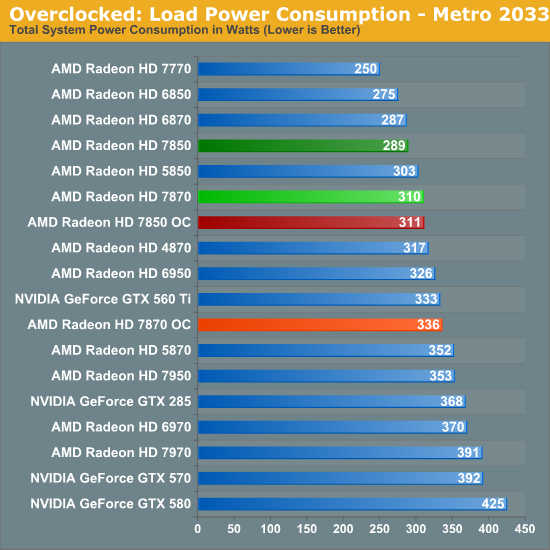
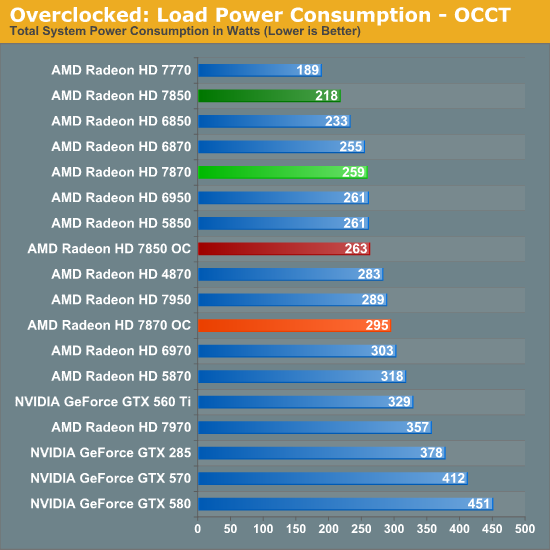
Even without a voltage increase overclocking does cause power consumption to go up, but not by a great deal. Under Metro the total difference is roughly 21W for the 7850 and 25W for the 7870, at least some of which can be traced back to the increased load on the CPU. Whereas on OCCT there’s a difference of nearly 40W on both cards, thanks to the increased PowerTune limits we’re using to avoid any kind of throttling when overclocked. All things considered with our overclocks power consumption for the 7850 approaches that of the 7870 and the 7870 approaches the GTX 560 Ti, which as we’ll see is a fairly small power consumption increase for the performance increase we’re getting.
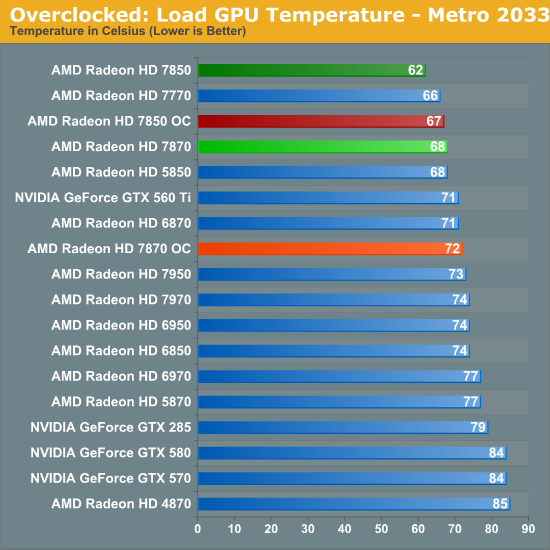
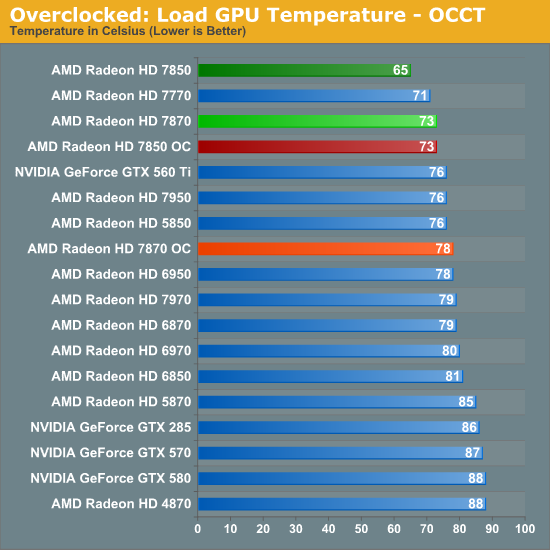
Of course when power consumption goes up so does temperature. For both cards under Metro and for the 7870 under OCCT this amounts to a 5C increase, while the 7850 rises 8C under Metro. However as with our regular temperature readings we would not suggest putting too much consideration into the 7950 numbers since it’s using a non-retail design.
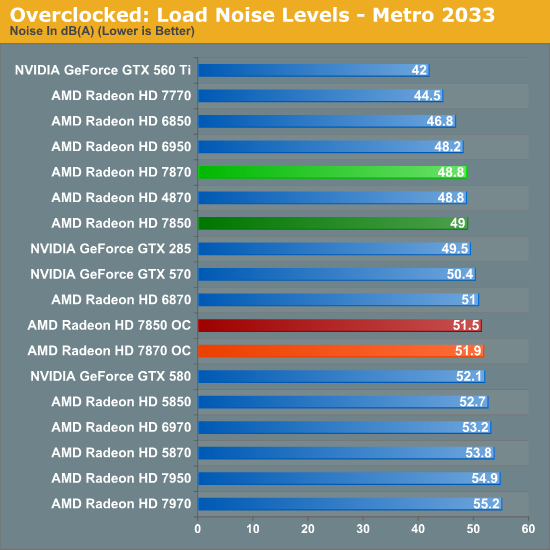
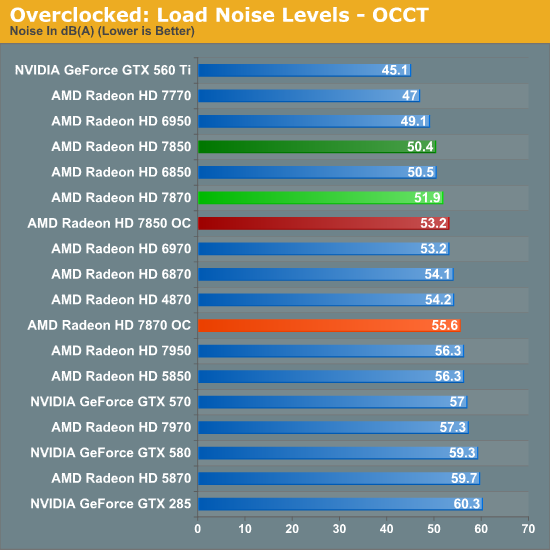
AMD’s conservative fan profiles mean that what are already somewhat loud cards get a bit louder, but in spite of what the earlier power draw differences would imply the increase in noise is rather limited. Paying particular attention to Metro 2033 here, the 7870 is just shy of 3dB louder at 51.9dB, while the 7850 increases by 2.7dB to 51.5dB. OCCT does end up being worse at 2.8dB and 3.7dB louder respectively, but keep in mind this is our pathological case with a much higher PowerTune limit.










173 Comments
View All Comments
fingerbob69 - Tuesday, March 6, 2012 - link
It ain't, the 7870 is faster by 25-33% depending on the res. Price wise it's about 30% more (UK) but that fits with the bump in performance. So, you're wrong.Houdani - Monday, March 5, 2012 - link
Hey! My mom was born on Pitcairn. It's the top of a blown off volcano, only 1x2 miles large. No correlation, I'm sure. Interesting.AlB80 - Monday, March 5, 2012 - link
It beats 6950. 6970 and 7850. Is it correct?haukionkannel - Monday, March 5, 2012 - link
Well these are good card even at this moment! Ofcource we can hope cheaper prizes, but that need at least two competitors and at this moment there is none...And I would not wonder if Kepler will be prices accordingly. Those kepler chip are bigger, if leak are true, so they should be faster and they definitely will be more expensive (if not counting those renamed low end cards tha allso AMD is releasing this time)
AMD is not getting profit (in total) and Nvidia has a lot of new staff going on that need a lot of money to develop, so there seems to be zero reason to both company to reduce the prices... pity but true.
If you have good 5000 or 6000 series card you don't need these (same as if you have good 6600 serieas cpu you don't need ivy...) at this moment. But if you need a lot of power for little power usage these are extremely good and allso as someone said, these are very small chips! So there is a lot of room for a little bit bigger for 8000 series. Tick tock... Seems to be a lot like Intel Ivy vs Hasvell. Ivy does not offer a much compared to sandy, only smaller power usage and a little bit better speed. Like someone else said, very similar situation.
Hubb1e - Monday, March 5, 2012 - link
The upgrade from a 5800 to a 7800 may be only 20-40% on stock clocks, but add in the extra headroom the 7800 has when overclocking and you're looking at a decent upgrade. Once the prices come down on these I'm sure you'll see quite a few folks dropping their 5800 for a 7800.PurpleMoose - Monday, March 5, 2012 - link
The 7850 (usually) slightly outperforms the 6950 despite having only 1024 shaders compared to 1408, with a ~7% core overclock (and a slight memory underclock). Even being conservative, that would make the GCN shaders about a third more efficient than the VLIW4 ones. But if we assume that a VLIW4 cluster performs more or less the same as a VLIW5 cluster, as does seem to be the case, then we can compare a hypothetical VLIW4-based 5770 with 640 shaders to the 7770. In this case the 7770 outperforms the 5770 basically by its clock speed difference, in other words clock for clock, shader for shader, VLIW4/5 vs GCN seems to be a wash.So why doesn't the 7700 series show as much (ie any) improvement?
The most obvious deficiency is the memory bus and memory bandwidth, but if thats the case why not add more? Alternatively, if you're happy with the performance as is, why not cut away a few more shader groups as it seems the card really can't use them, and save even more space? I had a very brief look for overclocked results and couldn't really find any - what I'd find really interesting is if anyone has benched a stock 7770 against a 7750 running at 7770 frequencies. I wonder how much the loss of shaders would hurt.
jesh462 - Monday, March 5, 2012 - link
Whenever I read an article on the new 7xxx series, I can't help but wonder if people remember what they're looking at. AMD moved to 28nm with this series. They also introduced a completely new architecture. They did so with no complications and without going overtime on the release date.This hasn't been done before. Even Intel doesn't attempt to do this with their CPUs. Tick, then tock, right?
Not only did AMD manage to get their new line up out, but the new cards have performance that exceeds their Nvidia counterparts on both the gaming and compute levels, in most cases. People who buy actual retail samples of the 7xxx series are pleased with the great overclocking headroom. It's obvious that there is a lot of room, even in the 7xxx series current iteration, for growth.
Despite all this, I still see people talk about how a 7xxx card isn't worth it, and how AMD is a sh*t company. Really? Ok.
Disclaimer, I own an i7 laptop with a geforce 560 blah blah.. fanboy whatever. Just think about this before you post. Yeah the new cards could use a price drop. We all know they will, sooner or later. That's why it's called the waiting game.
arjuna1 - Monday, March 5, 2012 - link
a 7xxx card is not worth it and AMD is not a sh*t company.I tend to agree with you for the most part but, there are no NVIDIA's counterparts for the 7xxx series, yet, and when there is, the 7xxx will go down in prices and then their value will increase.
CeriseCogburn - Thursday, March 8, 2012 - link
I'm sorry, we were promised southern islands for the 6000 series, and then, all that changed...What we really have here is a release that is like 2 years late.
Apparently once AMD re-announces it's new release schedule after admitting it missed it's last release target... all you people suddenly get a gigantic case of perfect amnesia.
To put it simply this is AN ENTIRE GENERATION LATE ON THE PROMISED RELEASE.
mattgmann - Monday, March 5, 2012 - link
Where is this misconception that the pricing is anywhere near acceptable on these new parts coming from? So they fit right in with the current price/performance ration. So what? AMD has basically put out a new line of cards that match their competitors previous generation and cost SLIGHTLY less.Aren't technologies supposed to get better? What's the point in upgrading if you get basically the same amount of performance for your dollar today as when you bought you last part?
Intel's new top end processors cost the same as last generation's, and the generation before that. New products replace old ones in pricing structures. AMD is raking in cash on these cards. They're less expensive to produce than last generation and retail for MORE money.
AMD is taking full advantage of their current market position, and instead of passing on ANYTHING to the consumer, is milking every profitable drop.
These cards' performance is impressive when compared apples to apples against last generation's equivalents. But since they basically all occupy a price slot a full tier higher than their predecessors, the comparison is moot.
Too bad the only 2 companies in the graphics card race are so ill equipped to advance the industry. AMD, Nvidia, get a clue.